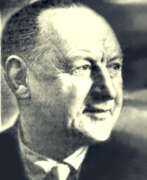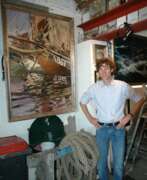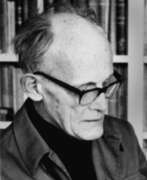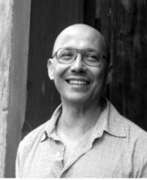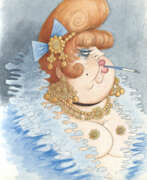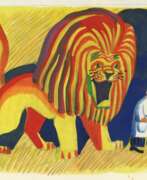Illustrators Contemporary art


Richard Adams is a British artist and illustrator living and working in Sussex.
Adams received an honors degree in graphic design from Leicester Polytechnic and initially worked as an illustrator in London. Richard Adams creates all his paintings using chalk pastels, then fixes and impregnates with a special varnish that leaves an impenetrable surface. He depicts a variety of English landscapes and seashores, often inhabited by quirky characters and animals, as well as amusing domestic scenes. The artist successfully captures the humor and absurdity of everyday life in a bygone and contemporary English style.
Adams' work is regularly exhibited in London and other UK cities to great acclaim, and internationally in Sydney, Washington DC, Bremen and Madrid.


Saleh al-Jumai'e is an Iraqi artist noted for his works that explore the notion of tracks left by ancient heritage. His works often integrate Arabic calligraphy in an abstract artwork. Al-Jumaie and his cohort became the group of artists that defined 1960s Iraqi art. Although al-Jumaie is best remembered as a painter, he also designed posters and produced a number of book covers. His early work features Arabic lettering, but over time the calligraphy became fainter. His interest in exploring new media and materials was maintained throughout his career. The idea of tracks left by tradition is a theme that Jumaie takes up in much of his work. For example, Pages from Old Books is a series of mixed media artworks that creates an illusion of surfaces on which fragments of script have been written.




Craig Alan is an American artist whose work displays a technical sophistication as well as a rich imagination.
After moving with his family to New Orleans, Alan worked as a street artist in his youth, creating portraits. Through his exceptional talent and through his own research, he eventually developed an admirable understanding and sense of textures, compositions and colors. Today, Craig Alan represents a wide range of artistic styles, from book illustration to naturalistic oil painting and his Populus Art.
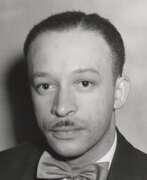

Charles Henry Alston was a mid-twentieth-century American artist. He is known as a graphic and muralist painter as well as a sculptor, illustrator, and educator who lived and worked in New York City's Harlem neighborhood.
Charles Alston was an activist in the so-called "Harlem Renaissance." He became the first African-American director of the U.S. Federal Art Project. The artist created murals for Harlem Hospital as well as a number of cultural and administrative buildings in New York City. Alston is the author of a bust of Martin Luther King, Jr. which was the first depiction of an African American to be displayed at the White House in Washington, DC.


Boris Izraelievich Anisfeld (Russian: Борис Израилевич Анисфельд) was a Russian-American painter, set designer, illustrator, and educator, celebrated for his vivid use of color and imaginative scenery. Born in Bessarabia, Russian Empire, in 1878, Anisfeld's artistic journey led him from the Odessa School of Art to the Imperial Academy of Arts in Saint Petersburg, where he absorbed the influences of prominent artists like Ilya Repin and Igor Grabar. His distinct style caught the attention of Sergei Diaghilev, leading to his work with the Ballet Russe before World War I.
Anisfeld's contributions to art extend beyond his canvas, as his theater designs for Diaghilev's Ballets Russes and collaborations with notable figures like Michel Fokine and Anna Pavlova showcased his ability to blend fantasy with performance. His work with the Ballets Russes, including designing the production of "Sadko" and executing the visions of other celebrated artists for stage sets, marked a significant period in his career before he immigrated to the United States in 1917.
In America, Anisfeld continued his legacy, taking on roles such as a teacher at the Art Institute of Chicago and contributing to the cultural landscape through his stage designs and paintings. His work is recognized for its innovative approach to color and form, bridging the realms of painting and theater design to create immersive, emotionally resonant artworks. Anisfeld passed away in 1973, leaving behind a body of work that continues to inspire and captivate audiences.
For collectors and experts in art and antiques, Anisfeld's work represents a fusion of Russian and American art traditions, enriched by his imaginative approach and vibrant palette. His contributions to the development of modern art and theater design underscore the enduring relevance of his creative vision.
To stay updated on exhibitions, sales, and auctions related to Boris Israelievich Anisfeld, sign up for updates. This subscription will ensure you're informed about new opportunities to explore and acquire works by this influential artist.


Kurt Ard was a Danish illustrator, painter and printmaker. He became internationally famous for his narrative cover artwork published in popular magazines of the 1950s-1970s, including the Family Journal, the Saturday Evening Post and Reader’s Digest. Ard started his career at various smaller newspapers and worked in the same realistic tradition as his role model, illustrator and painter, Norman Rockwell. During WW II, Kurt struggled to fulfill commission orders. His painting and his reputation and success grew steadily in the post war years. His illustrations soon appeared in major European publications, and he subsequently achieved international fame. Over the course of his career, Ard has sold more than 1000 illustrations to the best magazines in Europe, and to American publications such as McCalls, Good Housekeeping and Redbook. Today, Kurt continues to create exceptional figurative, landscape and seascape paintings with uncompromising authenticity , capturing the charm, beauty and power of these diverse subjects. His work is especially notable for its brilliant light and precise detail.


Karl Otto Bachmann, a Swiss painter, graphic artist, and illustrator, began his artistic career in Luzern before moving to Zurich and pursuing freelance work. He achieved a breakthrough in 1943 with the publication of his "Faust" portfolio. Bachmann drew inspiration from his travels across Europe, often joining circus troupes for income and creative ideas. His paintings were characterized by imaginative and virtual settings, with themes revolving around the stage, carnival, and circus. Bachmann's elegant lines, delicate colors, and harmonious compositions made him a respected book illustrator. He actively participated in numerous exhibitions throughout his life, both domestically and internationally.


Margit Balla is a Hungarian artist, graphic artist, illustrator, director, stage designer and costume designer.
She studied typography at the Academy of Applied Arts in Budapest, mainly making posters, book illustrations, later working more and more with pictorial graphics. In her posters Margit Balla combines impressions from old prints with contemporary trends such as pop art. Her figurative compositions are easily recognizable by her special surrealistic drawing style.
Since 2000, Margit Balla has been working as a production designer for the Budapest Puppet Theater.


Pavel Ivanovich Basmanov (Russian: Павел Иванович Басманов) was a Soviet and Russian artist of the twentieth century. He is known as a painter, book graphic artist and illustrator.
Pavel Basmanov devoted his entire career, beginning in 1929, to book graphics, and was a member of the bureau of the graphic section of the Union of Artists. He is also known for his series of watercolor works, including "Old Siberia" and "Walking". His art was characterized by a unique approach based on religious motifs.
The master's works are in the collections of the State Russian Museum, the Tsarskoye Selo State Collection and private collections.


Georgy Nikolaevich Bibikov (Russian: Георгий Николаевич Бибиков) was a Russian and Soviet artist of the mid-20th century. He is known as a painter, graphic artist, illustrator, muralist and theater artist of the Leningrad school, working in the genres of landscape, portrait, still life and thematic painting.
Georgy Bibikov began participating in art exhibitions in 1920. Among his famous works are "Loaders", "Young Red Fleets Receive Uniforms", "Greetings to the Winners", "Trench Truth" and others. His works are in the State Russian Museum and in museums and private collections in Russia, Ukraine, Germany and France.


Quentin Saxby Blake is an English cartoonist, caricaturist, illustrator and children's writer. He has illustrated over 300 books, including 18 written by Roald Dahl, which are among his most popular works.[a] For his lasting contribution as a children's illustrator he won the biennial international Hans Christian Andersen Award in 2002, the highest recognition available to creators of children's books. From 1999 to 2001, he was the inaugural British Children's Laureate. He is a patron of the Association of Illustrators.


Peter Brandes is a Danish painter, sculptor, ceramic artist and photographer.
Brandes' art is abstract and often in brown colours. He had his breakthrough as artist in the beginning of the 1980s. He has, inter alia, done artwork on Roskilde Domkirke and mosaic (colored glass) windows in a church at Nordkap and the church Village of Hope, south of Los Angeles. In 1998, he created the enormous Roskilde Jars which stand outside the main Roskilde Railway Station.
Brandes is self-taught and his art circles around themes from Christianity. Ancient Greek mythology has also inspired his art. Brandes has illustrated a number of books, for example Homer’s Iliad. A great part of Brandes' ceramic works are inspired by ancient Greek art and mythology.


Raymond Redvers Briggs was a British writer, illustrator, and cartoonist.
A professional illustrator, he worked on the design of children's books. In the 1960s, Briggs discovered his talent and ability to combine words and pictures, using a form of strip cartooning that defined his later work.
Briggs is best known for his wordless book The Snowman, published in 1978, a sort of cute children's tale but with deep meaning. The animated and musical versions of this book are popular in Britain and are shown annually at Christmas.


Jason Brooks is a contemporary British artist known for his fashion illustrations and portraits. He was born in 1969 and studied at Chelsea School of Art and Central Saint Martins in London. His work has been published in publications such as Vogue, Elle and The New Yorker.
Jason Brooks has worked with fashion brands including Chanel, L'Oreal and Christian Dior. As well as commercial work, he has exhibited his work in galleries around the world, including the Saatchi Gallery in London and the Museum of Modern Art in Tokyo.


Piotr Dmitrievich Buchkin (Russian: Пётр Дмитриевич Бучкин) was a multifaceted Soviet and Russian artist known for his contributions to painting, graphic arts, and teaching. Educated at the Higher Art School at the Imperial Academy of Fine Arts under Vasiliy Mate and Vasily Savinsky, Piotr Buchkin graduated in 1912, embarking on a journey that included travels across Europe to refine his artistry. His works span a variety of genres, including portraits, genre paintings, landscapes, and illustrations, showcasing his versatility across different mediums such as watercolor, pencil, pastels, etchings, oil, and tempera paintings.
Piotr Buchkin's engagement with the art world was profound; he was a founding member of the Leningrad Union of Artists and contributed significantly to the Leningrad School of Painting. Throughout his career, Buchkin participated in numerous exhibitions and was recognized for his talent as a graphic artist and portraitist, adept in various painting techniques. His memoirs, "About that in memory: Notes of an Artist," provide insights into his artistic journey and experiences.
Piotr Dmitrievich Buchkin's works are held in prestigious collections, including the State Russian Museum and the State Tretyakov Gallery, reflecting his esteemed position in the art community. His legacy continues to inspire, as his works are found not only in Russia but also in private collections and museums worldwide.
For collectors and experts in art and antiques, Piotr Buchkin's oeuvre offers a deep dive into the richness of Soviet and Russian art, particularly the Leningrad School. To stay updated on exhibitions, sales, or auctions featuring Buchkin's works, consider subscribing to relevant updates.


Bernard Buffet was a French artist renowned for his distinctive style of painting, printmaking, and sculpture. His work, characterized by expressive, angular lines and somber themes, has captivated collectors and art enthusiasts worldwide. Buffet's art, deeply influenced by the post-war period in France, reflects themes of despair, loneliness, and the human condition, often portrayed through his iconic clowns and desolate landscapes. His approach to art, marked by stark compositions and a vivid portrayal of existential angst, positioned him as a leading figure in the modern expressionist movement.
Buffet's career was meteoric from its onset; by his early twenties, he was celebrated alongside cultural icons of the time, earning him a spot among the "Fabulous Five" of post-war France. Despite his early acclaim, Buffet's later years were marked by controversy and a decline in popularity, as shifts in artistic trends and criticism over his lifestyle choices overshadowed his contributions. Nevertheless, his work remained prolific, with more than 8,000 paintings to his name, illustrating an unwavering commitment to his art until his tragic death in 1999.
Today, Bernard Buffet's legacy is undergoing a renaissance, with a renewed appreciation for his artistic achievements. Exhibitions and retrospectives across the globe, particularly in Japan and Europe, have reignited interest in his oeuvre, showcasing the enduring relevance of his work. Notably, the Bernard Buffet Museum in Japan, founded during his lifetime, stands as a testament to his impact and the global admiration for his art.
For collectors and experts in the field of art and antiques, Buffet's work offers a unique insight into the complexities of the human psyche and the existential dilemmas of the 20th century. His ability to evoke profound emotional responses through his distinctive visual language makes his work highly sought after in the art market today.
To stay informed about new product sales and auction events related to Bernard Buffet, we encourage you to sign up for updates. This subscription service is tailored specifically for enthusiasts keen on exploring the profound legacy of Bernard Buffet, ensuring you remain at the forefront of notable developments in the art world.


Lawrence W. Carroll was an Australian-born American painter who established a career on both sides of the Atlantic. In his early career Carroll worked as an illustrator for The Progressive, The Village Voice, The New York Times, and other periodicals drawing political illustrations. However it is Carroll's career as a painter that is most significant. His approach to materials, to the scale and structure of the objects is highly distinctive.


Jean Carzou (Armenian: Ժան Գառզու), birth name: Garnik Zouloumian (French: Karnik Zouloumian; Armenian: Գառնիկ Զուլումեան) was an Armenian-French artist: painter, graphic artist, scenographer, book illustrator, representative of the Paris School. Years of creative activity - 1925-1999. The characteristic definition of Karzu's works is "magic realism".
Jean Carzou's works demonstrate a unique combination of realism and fantasy. His ability to give ordinary scenes mystery and intrigue distinguishes his work. Depictions of bustling city streets, serene landscapes or poignant human figures evoke a sense of contemplation and encourage viewers to delve deeper into the subject matter of each work.


Jean-Pierre Cassigneul is a French artist known for his stylized paintings of women in fashionable clothing and elegant interiors. He was studied at the École Nationale Supérieure des Beaux-Arts in Paris.
Cassigneul's paintings often feature women with long necks, almond-shaped eyes, and vividly colored clothing set against simple yet elegant backgrounds. He has been influenced by the work of Henri Matisse, Pierre Bonnard, and Edouard Vuillard, as well as Japanese woodblock prints.
Cassigneul's work has been exhibited in galleries and museums around the world, including the Tokyo Museum of Modern Art, the National Museum of Fine Arts in Buenos Aires, and the Museum of Modern Art in Paris. His paintings are also held in the collections of many prestigious institutions, including the Musée d'Art Moderne de la Ville de Paris and the Museum of Modern Art in New York.
In addition to his paintings, Cassigneul has also worked in other media, including lithography and book illustration. He has created illustrations for works by Gustave Flaubert, Paul Verlaine, and Charles Baudelaire, among others.
Cassigneul continues to work and exhibit his art today, and is considered one of the leading figures of the contemporary French art scene.


Fabrizio Clerici was an Italian painter, draftsman, illustrator, scenographer and architect.
Clerici earned a degree in architecture and was greatly influenced by antiquities, Renaissance and Baroque painting and architecture. In 1943, Clerici held his first solo exhibition at the Galleria dell'Arte Cairola in Milan, featuring drawings, watercolors, lithographs and etchings. His first book illustrations belong to the same period.
In 1947, Clerici began a prolific career in theater, ballet and opera with his debut as a stage designer in a production of George Bernard Shaw's play Mrs. Warren's Profession. The following year he participated for the first time in the Venice Biennale. There he met Salvador Dalí and created the sets and costumes for Igor Stravinsky's Orpheus, which was performed at the La Fenice Theater. In 1949 he created large-scale architectural fantasy paintings.
The further life of the multifaceted artist Fabrizio Clerici was full of work in a variety of fields of art, creative successes and exhibitions. His work has been exhibited in many museums in the United States, including MoMA and the Guggenheim Museum, as well as in France, such as the Pompidou Center.


William Glen Crooks, an American neorealist painter, has carved a niche for himself with his unique approach to landscape and urban scene painting. Unlike traditional representations, Crooks' works omit human figures, substituting them with vehicles to embody human traits and emotions. His approach to capturing the essence of city and small-town life through this lens has garnered attention for its depth and thoughtfulness. William Glen Crooks' dedication to his craft began at a young age, evolving from drawing comics to a self-taught mastery in representational painting, driven by a passion to defy the norms of modernism that dominated his formative years. His self-imposed rigorous practice of drawing laid the foundation for his distinctive style.
William Glen Crooks' work has been the subject of several exhibitions, including a notable showcase at the Oceanside Museum of Art (OMA). The exhibition, "The Point of View," marked his first museum exhibition and featured twenty-three paintings that spanned over twenty-five years. These works emphasize cityscapes, nostalgic urban scenery, and expansive landscapes, illustrating Crooks' ability to translate everyday scenes into compelling narratives. His paintings are celebrated for their illumination of light and shadow, transforming landscapes into metaphors that reflect his perceptions of the natural world.
His technique and subject matter draw inspiration from a blend of influences, including the landscape painters of the 1800s, Edward Hopper's narrative style, Mark Rothko's color fields, Wolf Kahn's liberating techniques, and John Frederick Kensett's luminism. This eclectic mix has allowed William Glen Crooks to explore the opacity of light and transparency of shadow in a way that brings a fresh perspective to the landscape genre, making his work resonate with a contemporary audience while retaining a timeless quality.
For collectors and experts in art and antiques, William Glen Crooks offers a unique investment in the realm of contemporary realism. His paintings invite viewers to explore the subtle interplay of light, shadow, and form, capturing the quiet moments of daily life with a profound depth and sensitivity.
To stay updated on William Glen Crooks' latest works and exhibitions, signing up for newsletters from galleries and museums that feature his work, such as the Oceanside Museum of Art, is recommended. This subscription will ensure that enthusiasts are always informed about new sales, auction events, and showcases related to Crooks' evolving portfolio.


Rostislav Alexandrovich Danov (Russian: Ростислав Александрович Данов) was a Soviet artist of the late twentieth century. He is known as a graphic-animalist, naturalist, writer and professional snake artist.
Rostislav Danov began practicing animalistics in the last years of his life. He was the author of many works, some of which are kept in the Darwin Museum in Moscow. The artist illustrated books, including "Rare and Endangered Animals. Amphibians and Reptiles." Gorlov was also working on an unfinished book, "Year of the Snake," where he planned to describe the seasons of Turkmen nature through the eyes of a gyurza. His manuscripts, hundreds of drawings and 15 volumes of field diaries with graphic sketches have been preserved.


Gérard de Palézieux is a Swiss painter and engraver.
From the very beginning, Palézieux's vocation was to attempt to render, as closely as possible to his emotions, the spectacle of the world - landscapes, interiors, objects, flowers or fruit. A rare occurrence in his time, characterised by constant questioning of the status of art and representation, he was never shaken by fashions and persevered alone in the faithful translation of reality.


Maynard Dixon was an American painter and illustrator. Dixon became known for his Western landscapes, Native American images, scenes of cowboys and shepherds, and his work during the Great Depression.
Dixon studied in San Francisco and New York, where he worked in magazine illustration. He also traveled throughout Europe, where he found inspiration in the work of Renaissance artists and the Impressionists. Upon his return to the United States, however, he began to pursue the genre of Western painting, which became his main passion. One of Dixon's most famous series of works is The Myth of the West, in which he depicted the Western landscape and cowboys using bright colors and geometric shapes. His work was popular in the 1920s and 1930s, and he was often invited to exhibit his work in museums and galleries.
In addition, Dixon also worked as an artist-designer for film studios, creating sets and costumes for Westerners. His work has been used in such famous films as Mutiny on the Bounty, The Sheriff, and Mighty Joe Yankee. Maynard Dixon's work is in the collections of many museums, including the National Museum of Western Painting in Oklahoma City and the Fenimore Cooper Museum in New York City.


Miodrag Djuric (Montenegrin: Миодраг Ђурић), known as Dado, was an artist born in Montenegro who spent most of his life and creative career in France. He is particularly known as a painter but was also active as an engraver, draftsman, book illustrator and sculptor.


Paul Dom, born Paulus Ludovicus Carolus Dom, was a Belgian and Dutch painter and illustrator.
He studied at the Royal Academy of Fine Arts in Antwerp, lived in Belgium and the Netherlands, was granted Dutch citizenship in 1936 and lived in The Hague for the rest of his life.
Paul Dom was a versatile artist. He dabbled in drawing and painting and painted portraits, cityscapes and sketches, and genre scenes. At the same time he was a political cartoonist and illustrated books. Between 1917 and 1956 Dom illustrated hundreds of books, mostly for children.


Thomas Duttenhoefer was a German sculptor, draughtsman, graphic artist, and illustrator, and professor at the University of Mannheim.
In addition to his human figures, Thomas Duttenhoefer's figurative work includes many depictions of animals in a deliberately crude manner.
He is a member of the New Darmstadt Secession, the Palatinate Secession and the Argo Group, Speyer.


Klaus Eberlein was a German graphic artist, illustrator and ceramic sculptor. He initially completed training as a chromolithographer. From 1962 to 1968 he attended the Academy of Fine Arts in Munich, and from 1968 he was a master student of Hermann Kaspar, receiving a final diploma from the academy. Eberlein was a member of the Association for Original Etching, the Dachau Artists' Association and the Munich Artists' Association. In 2013 he was accepted into the South German literary association Münchner Turmschreiber.


Ivan Semyonovich Efimov (Russian: Иван Семёнович Ефимов) was a Russian and Soviet artist of the first half of the twentieth century. He is known as an animal painter, graphic artist, sculptor, illustrator and reformer of the puppet theater.
Ivan Efimov worked in different genres and techniques, but all his work, including decorative and applied art, was focused on animalistic themes. He created works for the Moscow subway, train stations, sanatoriums and many other places and became famous for his technique of through volume relief in sculpture. The master also illustrated more than 20 books.
Efimov also created erotic works - about a thousand sheets with various thematic series, but the public learned about them only after the collapse of the USSR.


Ellen Kristina Abelli Elander is a Swedish artist, illustrator and sculptor.
She was educated at Birkagårdens folkhögskola and at the beginning of her artistic journey she was interested in the monstrous and the morbid, the grotesque and the cannibalistic. Later on the figure of the Alien appears and becomes central in Elander's works, participating in human life in one way or another.
The artist uses painting, drawing, textile sculpture and ceramics to express her ideas, creates spatial installations, and also draws comics.


Frantisek Emler was a Czech painter, draftsman, graphic artist, illustrator, and stage designer.
He studied at the Academy of Fine Arts in Prague, was a student at the Academy of Fine Arts in Rome, and then at the Ecole Nationale Supérieure des Beaux-Arts in Paris.
Emler painted still lifes and portraits, but his main subject was landscape painting. He was the author of sets for several opera and theater productions and also illustrated several books.


Maria Paula Figueiroa Rego was a Portuguese-British visual artist known particularly for her paintings and prints based on storybooks. Rego's style evolved from abstract towards representational, and she favoured pastels over oils for much of her career. Her work often reflects feminism, coloured by folk-themes from her native Portugal.








